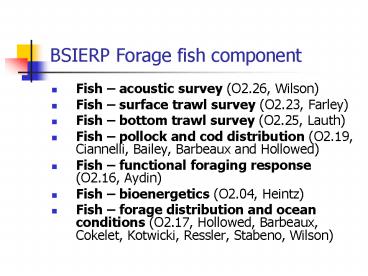BSIERP Forage fish component - PowerPoint PPT Presentation
1 / 36
Title: BSIERP Forage fish component
1
BSIERP Forage fish component
- Fish acoustic survey (O2.26, Wilson)
- Fish surface trawl survey (O2.23, Farley)
- Fish bottom trawl survey (O2.25, Lauth)
- Fish pollock and cod distribution (O2.19,
Ciannelli, Bailey, Barbeaux and Hollowed) - Fish functional foraging response (O2.16,
Aydin) - Fish bioenergetics (O2.04, Heintz)
- Fish forage distribution and ocean conditions
(O2.17, Hollowed, Barbeaux, Cokelet, Kotwicki,
Ressler, Stabeno, Wilson)
2
The Hypothesis
- As heat content increases, the quality,
distribution, and area of habitat for spawning
and foraging by subarctic fish species will
change leading to a shift the spatial
distribution and vital rates of fish. - Shift in prey
- Shift in environmental conditions change in
frontal boundaries, cold pool, features - Shift in predators predator avoidance
- Competition for habitat density dependence
- Shift in timing of key events (stratification,
onset of reproductive cycle)
3
Acoustic-midwater Trawl SurveyJune-July annual
Underway (T,S, O2, Nitrate, Chl. Fluorescence)
Multi-frequency sampling
XBT MBT CTD
Augmented small net sampling (Methot)
4
Surface Trawl SurveyAugust-September annually
Acoutics (Horne)
Midwater sampling (Horne)
5
Bottom Trawl SurveyJune-July annually
Underway T, S, Chl Fluorescence (one
vessel) Rugged CTD on both vessels
6
(No Transcript)
7
BSIERP Forage fish component
- New data analysis techniques
- Retrospective studies to assess hypotheses.
- Spatial statistics (growth, distribution, food
habits, reproductive biology)
8
Results summer 2006
9
Acoustic data from commercial fishing vessels
10
How Roe Data Relates to Spawning Time
- As pollock get closer to spawning, the eggs
become hydrated. - This effects the quality and price of the roe.
- Therefore by looking at the quality of the roe
and date it is possible to approximate spawning
time.
11
CPUE and SST 1997 Week 18
12
End
13
Rugged CTDs for Summer Bering Sea Bottom Trawl
Survey Net Tows
Falmouth Scientific Instruments NXIC CTD
NXIC DT-705 passing the U.S. Navy Class A shock
test
14
(No Transcript)
15
Extra slides follow
16
Satellite data
- Each week over 131,000 points of sea surface
temperature were retrieved. - Due to cloud coverage some weeks had less data
than others. - The data was then put into ArcGIS to make maps
like this
17
Sea Surface Temperature 1997 Week 20
18
Sea Surface Temperature 1997 Week 21
19
Sea Surface Temperature 1997 Week 22
20
- Attached are 3 slides for your BSIERP planning
presentation next week. Let me know if I can
answer any questions.Fig. 1 A typical
thermosalinograph and fluorometer installation
in a Bering Sea fishing boat (i.e. F/V Great
Pacific).Fig. 2 Map of the 2006 bottom trawl
survey. Note 2 different colors for 2
different vessels. The main point to make is
that right now we have funding to instrument
both boats with CTD for the trawl head ropes,
but to fit just one vessel with underway
oceanographic instruments. Imagine the picture
with just the green dots sampled, when we could
have sampled the red dots as well!Fig. 3
Pictures of the rugged CTD for the bottom trawl
head ropes and a U.S. Navy version of the CTD
passing a shock test.
21
Acoustic-trawl surveys in the eastern Bering Sea
- Main source of monitoring data on midwater
walleye pollock
- Standard practice 38 kHz backscatter data is
visually examined and classified by trained
analysts
22
Results summer 2006
11
23
Results summer 2004
- A contrasting survey year
- Different backscatter patterns present a
challenge for classification algorithms - Physical (2004 warm, 2006 cool) and biological
factors both describe available pollock habitat
24
Results summer 2004
25
(No Transcript)
26
(No Transcript)
27
Conclusions and future directions
- Euphausiid algorithm appears to work well and
provides important new information - Application describe and monitor the pelagic
habitat of walleye pollock - Swimbladdered fish algorithm method does well at
discerning pollock in some situations, but needs
tuning - Application assisting classification of survey
data, processing data from vessels of opportunity
28
Acknowledgments
- Scientists of the AFSC Midwater Assessment and
Conservation Engineering (MACE) Program - Skipper and crew of NOAA Ship Miller Freeman
Photo credit Chris Wilson
29
Results summer 2004
11
30
Sea Surface Temperature 1997 Week 13
31
Sea Surface Temperature 1997 Week 14
32
Sea Surface Temperature 1997 Week 15
33
Sea Surface Temperature 1997 Week 16
34
Sea Surface Temperature 1997 Week 17
35
Sea Surface Temperature 1997 Week 18
36
Sea Surface Temperature 1997 Week 19































